Topic 1: Cell biology 
This page contains multiple choice questions in the style of Paper 1 of the Biology exams.
They test the breadth of your knowledge of the understandings and skills about cell biology.
To spend more time reviewing the topic before answering these questions, use the revision resources.
Cell biology revision resources
This page lists the understandings and skills expected for Topic 1 and links to the sub-topic pages which contain detailed revision notes, activities and past paper style questions. Great for revision.
Learn from any mistakes. Every question has an examiner's explanation that appears when you check your answers.
Huntington's Disease (HD) is a brain disorder that affects a person's ability to talk, and move. HD is caused by a faulty protein. The job of the protein is to direct vesicles containing important molecules to the outside of the cell. The chemicals are released when the vesicle reaches the membrane.
What is the name given to the release of chemicals by a cell in this way?
This is a type of secretion, the vesicle fuses with the plasma membrane and its contents are released. This is called "exocytosis".
The DNA of eukaryote cells is organised into chromosomes
What happens to the DNA at prophase in the beginning of mitosis?
Chromosomes condense by supercoiling during mitosis. This makes the chromosomes visible.
The DNA replicates during interphase, not prophase.
Sodium channels are made from a protein.
Where in the cell are sodium channel proteins found?
Sodium channel proteins are found spanning the plasma membrane. Their structure helps the function for facilitated diffusion in cells because they allow ions to pass cross the membrane.
If the protein was not a trans-membrane protein then it would not be able to transport ions across the membrane.
The four cells shown below have each been surrounded by a solution for 1 hour.
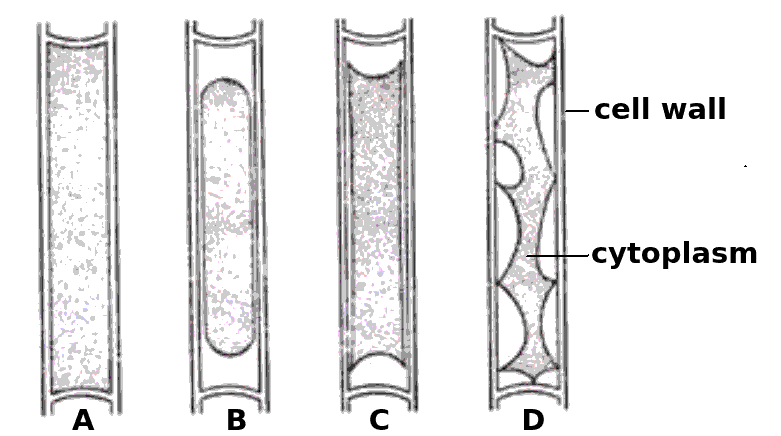
Which cells have been in a hypertonic solution ?
Cell A is swollen turgid, it is in a hypotonic solution or an isotonic solution.
The cells B, C and D show increasing signs of plasmolysis, and so they must be in hypertonic solutions.
Skill: Estimation of osmolarity in tissues by bathing samples in hypotonic and hypertonic solutions. (Practical 2)
Which of the following is true of peripheral proteins in cell membranes?
Membrane proteins are diverse in terms of structure, position in the membrane and function.
Peripheral proteins are attached to the membrane but found on its surface.
The electron microscope image below shows a ciliated epithelial cell from the trachea.
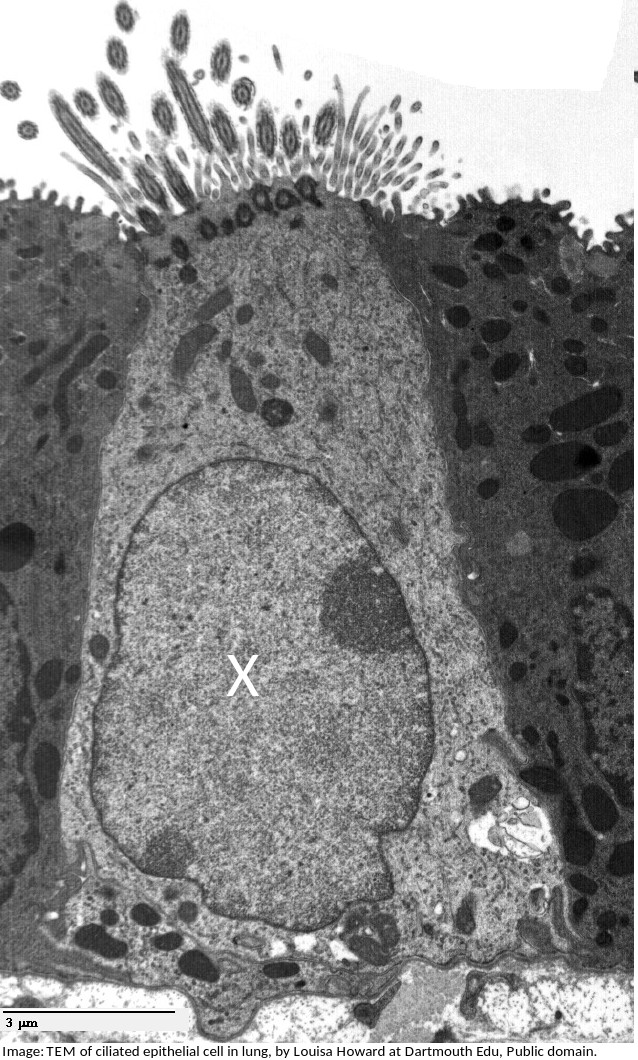
What is the name of the organelle labelled X?
What is the importance of surface area to volume ratio to cells?
Surface area to volume ratio is important in the limitation of cell size. The lager the volume, the greater the need for materials which have to be exchanged over the surface of the cell.
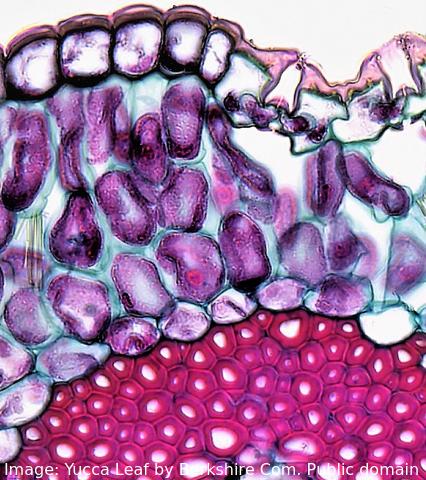 The image shows a range of different cell types in the leaf of a Yucca plant.
The image shows a range of different cell types in the leaf of a Yucca plant.
How do stem cells form this range of cells?
What is the process called?
Specialised tissues can develop by cell differentiation in multicellular organisms.
Differentiation involves the expression of some genes and not others in a cell.
The blood cells below were imaged using an electron microscope.
The magnification is x3000 and the ruler measures the central cell as being 2 cm in diameter.
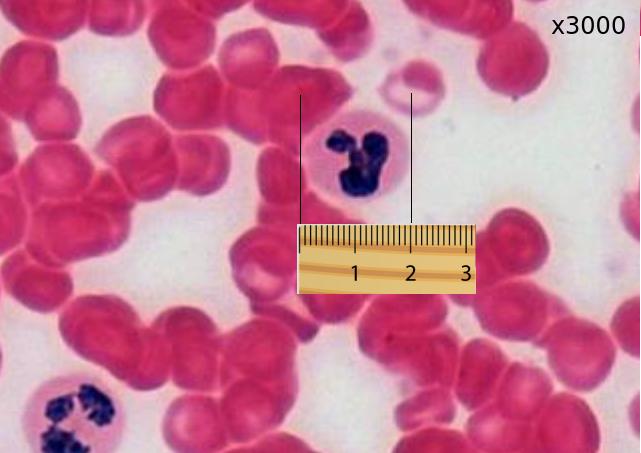
Estimate the actual size of this white blood cell.
Calculate specimen size using magnification?
First change the size measurement into µm units = 20000µm
Then divide by the magnification. 20000 / 3000 = 20 / 3 = 6.6 µm
The diagram shows the transport of sodium ions across a membrane.
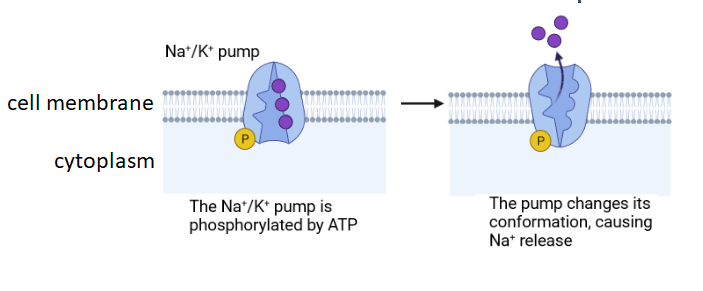
Which explanation gives the best description of the type of membrane transport shown?.
Facilitated diffusion does not require energy from ATP so this process is active transport. It can move sodium ions against the concentration gradient, but this is not always the case.
The diagram shows a typical eukaryotic plant cell. Which organelles are involved in supporting the cell and plant? I Cell wall II Cytoplasm III Nucleus IV Vacuole.

The cell and plant are supported by the turgor pressure of water in the vacuole acting on the rigid cell wall.
Which organelle in a eukarytotic animal cell synthesises proteins for exocytosis?

The RER synthesises proteins for exocytosis.
The image is of a prokaryotic cell. Which feature defines the cell as prokaryotic?

The lack of a membrane bound nucleus (nucleoid) classifies a cell as prokaryotic.
What is the structure of the genetic material found in a mitochondrion?
Mitochondrial DNA is a single helical molecule, not associated with protein and circular in shape. The same as prokaryote nucleoid DNA.
The theory of spontaneous generation has been disproved by Pasteur's experiment. Is there a point in evolution when spontaneous generation did occur?
The first cells must have arisen spontaneously from non-living matter, probably in volcanic vents, but the universal nature of cell ultrastructure and of the genetic code makes it likely that this only happened once.
Which of the following contributed to the acceptance of the fluid mosaic model of membrane structure of Singer and Nicholson in place of the original Davison-Danielli model?
I Hydrophobic membrane proteins
II Irregular sizes of membrane proteins
III Increased magnification of light microscopes.
IV Fluorescent antibody tagging.
The irregular sizes and insolubility of hydrophobic membrane proteins indicated that they could not be a surface layer as proposed by Davison-Danielli. This was confirmed by fluoresecent antibodies showing that proteins were both within and on the membrane.
Which of the following is the best description of an organelle?
The "wrong" answers are correct statements but are distractors, not the best description.
Why is the cell component in the image regarded as an organelle?

The organelle is a cell component with a membane, the mitochondrion, it is adapted to aerobic respiration.
There are twenty complete cells in this microphotograph (with complete nuclear material). Estimate the number of complete cells in prophase of mitosis.

There are 3 complete cells in prophase (chromosomes visible in a nucleus..
A tissue is placed in an isotonic solution. Which of the following is the best description of water movement between the tissue and the solution?
There is no net water movement, gain and loss from the tissue is equal in both directions.
Refresh this page to try a new set of 20 multiple choice questions. The questions will be different next time you visit. Great revision.

 Twitter
Twitter  Facebook
Facebook  LinkedIn
LinkedIn